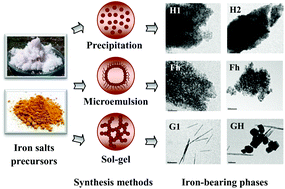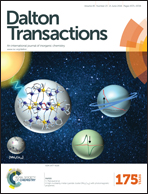The effect of the synthetic route on the structural, textural, morphological and catalytic properties of iron(iii) oxides and oxyhydroxides†
Abstract
A variety of iron(III) oxides and oxyhydroxides were synthesised and characterised using three distinct methods of preparation: microemulsion, precipitation and sol–gel. The results clearly showed that the structure, textural properties, crystal morphology and catalytic performance of the phases obtained were highly dependent on the chemical routes used for the synthesis. Precipitation and microemulsion methods allowed obtaining mesoporous nanostructured iron(III) oxides with mean particle sizes of 4 nm (amorphous hematite) and 7 nm (ferrihydrite), which exhibited a high surface area (291.4 m2 g−1 and 192.3 m2 g−1, respectively) and a very good catalytic behaviour in the advanced oxidation of highly non-biodegradable wastewaters. The different conditions employed in the synthesis of these materials through the sol–gel method yielded two goethites with practically the same catalytic properties, but dissimilar morphologies and texture. When soft agitation and slow addition of the precipitating agent were used, the resulting material (G1) was made up of shorter and finer particles, markedly acicular, with an average length of 400 ± 50 nm and width of 15 ± 5 nm. However, vigorous agitation and rapid addition of the precipitating agent led to the formation of longer and coarser particles, moderately acicular, the average length and width being 950 ± 100 nm and 140 ± 20 nm, respectively. The use of the sol–gel technique also resulted in the formation of a solid consisting of a mixture of hematite as the main crystalline phase and goethite particles dispersed among the hematite particles. This solid presented a low specific surface area (13.2 m2 g−1) and lower catalytic activity. Therefore, precipitation and microemulsion proved to be the most suitable techniques to synthesise catalytically active disordered iron(III) oxide nanoparticles, due to the presence of highly reactive non-stoichiometric iron(III) ions, a higher surface area and smaller particle sizes.


 Please wait while we load your content...
Please wait while we load your content...